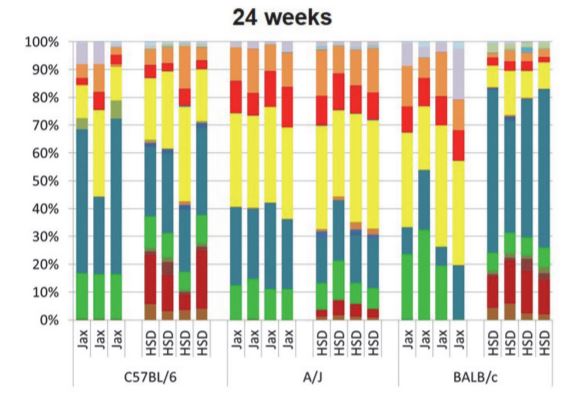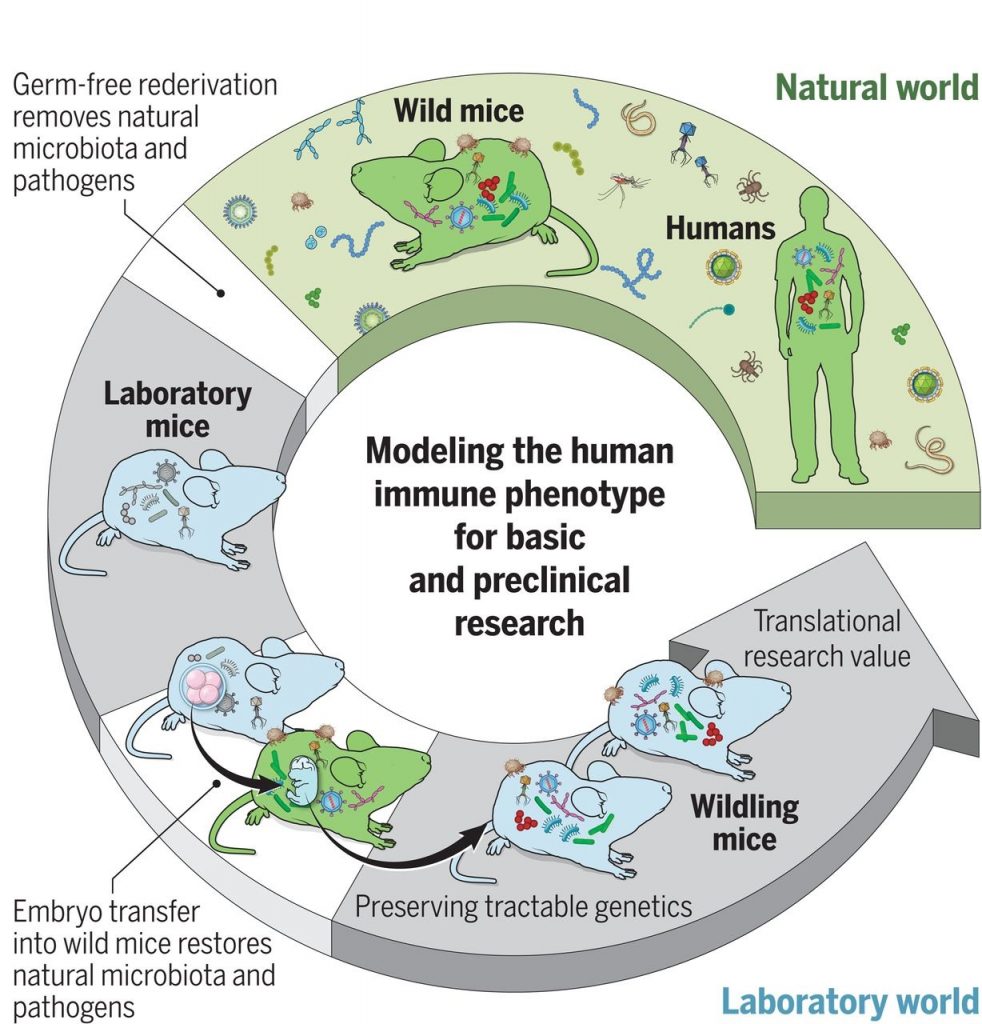

The Importance of Gut Microbiota in Reproducibility and Translatability in Research
The microbiota is the ecological community of commensal, symbiotic and pathogenic microorganisms that lives in our bodies. It is estimated that we have about 10 times more microbial cells than human cells in our bodies (1). We now know that the gut microbiota role goes beyond gut health, and can have an influence on cardiovascular and respiratory diseases, cancer, diabetes/obesity, autism…etc.
To learn more, see our previous blog : Solutions for your Germ-Free and Gnotobiotic Mice
So what does that mean for mouse models used in research for these diseases? When reporting and publishing results, scientists have to describe in detail the conditions in which the experiments take place (2), as any change in the following variables can affect the results:
- The experimental animals themselves: species, strain, sex, age, weight, source, genetic modification, genotype…
- The housing and husbandry: light/dark cycle, temperature, food, water, cage, bedding, enrichment….
- Experimental procedures: how, when, where, why
- Study design: number of animals and groups, type of controls, numbers of replications
Should the microbiota therefore be taken into account as much as the other variables? Current research suggests that the answer is a resounding yes, with growing evidence showing that the gut microbiota of laboratory mice similarly modulates the phenotype of the mouse models of human disease. In addition, several studies have shown that the microbiota is a primary determinant of disease severity (3).
Factors Influencing the Gut Microbiota
Different factors that can alter the gut microbiota:
- Diet* (formulation, shelf life, manufacturing process, sterilization process)
- Husbandry (cage type, bedding, water, housing density)
- Source (commercial vendors, repository, collaborators)
* As with any other variables, it is best to use matching controls, and to submit the controls to the exact same conditions as the experimental animals. For example, if a cup of DietGel® is added to the experimental animals group for nutritional support, the control group should be receiving the same treatment.
Ericsson et al. (4) compared the gut microbiota of C57BL6 from different commercial vendors (The Jackson Laboratory, Charles River Laboratories, Taconic and Harlan) and demonstrated significant differences in the richness and diversity of fecal microbial populations in mice from 3 weeks to 6 months of age (see data below).



This data highlights the need to acknowledge vendor-dependent differences in the composition of the mice microbiota and to characterize it to the best of one’s abilities, recognizing that it may play a role in the phenotype observed. The microbiome should be considered a component of your studies as much as genetics. If you manipulate the microbiome, what does it do to your model? For example, microbial strains such as Helicobacter or SFB (Segmented filamentous bacteria) have been shown to have profound effects on many mouse models.
Incorporating Gut Microbiota in your Research Models
How can you incorporate the effects of microbiota in your research models? There are a few different ways to transfer microbiota to your strain of interest (5):
- Embryos transfer in different surrogate strains carrying the microbiota of interest: this is the most reliable method. All pups will be isogenic, but carrying a different microbiome. The first generation of pups is directly available for early life studies. The microbiota remains stable and can be maintained for at least nine generations. However, the cost and expertise in embryo transfer technique can be limiting factors.
- Cross-fostering* with different strains of surrogate mothers: this method is easy and low cost. However, cross-fostering requires careful consideration for timing of pup transfer to a surrogate dam and housing environment as cannibalism of newly transferred pups can occur. Even when successful, the transfer can be incomplete, resulting in a hybridized microbiome.
- Co-housing* is a method where mice of the desired model are housed with donor mice colonized by a differing gut microbiome profile. It is also easy to perform and cost-effective, but incomplete microbiome transfer can occur, resulting in a hybrid microbiota.
- Fecal microbiota transfer* can be utilized to colonize weanlings or adult mice, previously given an antibiotic cocktail, with complex fecal material isolated from a donor. Frozen fecal material could be used with the same efficacy as fresh fecal material, allowing researchers to freeze and bank multiple samples for later use (6)
*These last 3 methods do not provide gut microbiota in utero or immediately at birth thereby requiring additional breeding generations for the study of early life events.
Effect of Microbiota on Reproducibility and Transferability
What to do when the phenotype of your mice is changing, when you observe poor reproducibility in your results and when the model shows some inconsistency? Check the microbiome of your animals! By characterizing the microbiome of affected versus unaffected mice, or mild versus severe phenotype, you can identify target bacterial species associated with either phenotype, and reconstitute the microbiome of interest.
There are different levels of colonization by the microbiota (7):
- Axenic or germ-free mice are free of all microorganisms including bacteria, viruses, fungi, protozoa, and other parasites. They are an ideal tool to determine whether or not microbiota, in general, plays any role in a model phenotype
- Monoxenic or mono-associated animals are germ free mice that have been colonized by only one microbial species. They allow for the study of responses to a single agent.
- Defined microbiota animals are germ-free inoculating with various “cocktails” of known bacteria or other agents. One example of such cocktail is “altered Schaedler’s flora” (ASF) that is now most commonly used in gnotobiotic research.
- Xenografted microbiota mice are germ-free mice reconstituted with more complex microbiota that are not completely defined, most commonly from human fecal samples. Indeed, while mice and humans share common bacterial populations in their intestinal microbiota, there are marked differences and the direct use of humanized microbiota may offer a more directly translatable model of diseases.
- Wild mouse/ pet store mice are exposed to infectious diseases and naturally occurring inflammatory immune stimuli. Recently, wild mouse (wildling) microbiota has been shown to promote host fitness and improves disease resistance (8). This new model, now available at Taconic, may enable discovery of protective mechanisms relevant in complex diseases and could improve the translation of research in mice into advances in human health (see diagram below from 9)

For samples, click here
Inspired by AALAS webinar of March 18, 2020 “Gut Microbiota: Variability and Translatability in Rodent Models” – Dr. Craig Franklin, DVM, PhD, DACLAM.
01/29/2020: How to Manage Barbering Behavior in Breeding Colonies
03/04/2020: Proper Perioperative Procedures in Rodents Promote Faster Recovery
03/30/2020: The Importance of Gut Microbiota in Reproducibility and Translatability in Research
06/01/2020: Pain is a Variable that Affects Data Reproducibility
07/14/2020: Understanding the Grimace Scale as a Pain Assessment for Laboratory Animals
Read our microbiota blog series:
Solutions for your Germ-Free and Gnotobiotic Mice
The Importance of Gut Microbiota in Reproducibility and Translatability in Research
The Role of Diet in the Gut Microbiota: Standard vs. Purified Diets
References
(1) How microbes define, shape — and might even heal us Rob Knight
(2) Animal research: Reporting in vivo experiments: The ARRIVE guidelines – Carol Kilkenny et al., Br J Pharmacol. 2010 Aug
(3) Differing Complex Microbiota Alter Disease Severity of the IL-10−/− Mouse Model of Inflammatory Bowel Disease – Marcia L. Hart et al., Front. Microbiol. May 2017
(4) Effects of vendor and genetic background on the composition of the fecal microbiota of inbred mice – Ericsson AC et al., PLoS One. 2015 Feb
(5) Development of outbred CD1 mouse colonies with distinct standardized gut microbiota profiles for use in complex microbiota targeted studies – Marcia Hart Sci Rep. 2018
(6) Variable Colonization after Reciprocal Fecal Microbiota Transfer between Mice with Low and High Richness Microbiota – Ericsson et al., Front. Microbiol., Feb 2017
(7) Manipulating the Gut Microbiota: Methods and Challenges – Ericsson AC and Franklin CL, ILAR J. 2015
(8) Wild Mouse Gut Microbiota Promotes Host Fitness and Improves Disease Resistance – Rosshart et al., Cell 2017
(9) Laboratory mice born to wild mice have natural microbiota and model human immune responses – Rosshart et al., Science 2019

